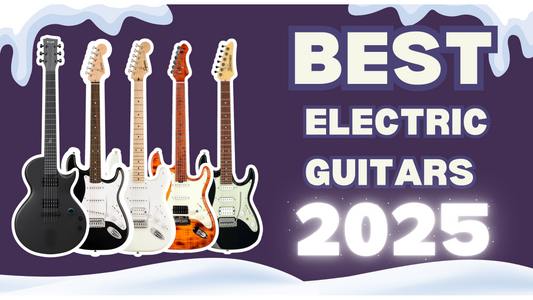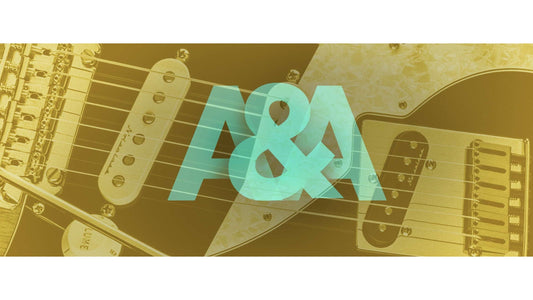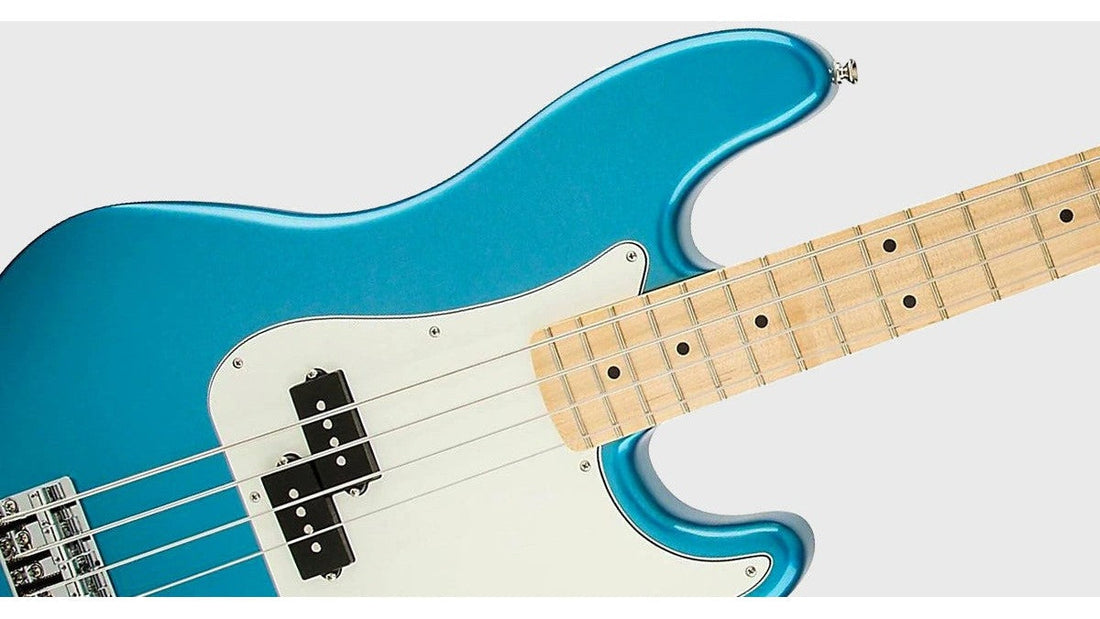
Cẩm Nang Chọn Mua Đàn Guitar Bass
Guitar bass neo giữ âm thanh và thêm hương vị cho nhịp điệu trong mọi thể loại âm nhạc.
Một người chơi có kinh nghiệm cũng có thể đóng góp những bản hòa âm phong phú và những bản độc tấu đáng ngạc nhiên trên guitar bass điện. Bởi vì nó được sử dụng trong hầu hết mọi phong cách âm nhạc hiện đại, người chơi bass có thể dễ dàng tìm thấy một ban nhạc để làm việc cùng. Guitar bass cũng tương đối đơn giản, dễ hiểu và thú vị để học. Tuy nhiên, sẽ rất hữu ích nếu bạn biết một vài điều cơ bản về guitar bass khi lần đầu tiên chọn một cây đàn.
Mục đích và Ngân sách
Guitar bass rất khác nhau về chất lượng và giá cả, vì vậy trước khi mua, hãy xác định số tiền bạn muốn chi tiêu.
Đối với những người mới bắt đầu không chắc chắn về khả năng và độ lâu dài của mình trong việc học chơi bass, có rất nhiều loại bass “khởi đầu” tốt, giá cả phải chăng. Những cây đàn này thường có phần cứng và thiết bị điện tử chất lượng thấp hơn, nhưng chúng thường rất dễ chơi và sẽ phục vụ tốt cho người chơi bass mới trong giai đoạn đầu học.
Tuy nhiên, những người chơi chuyên nghiệp hoặc có kinh nghiệm hơn có thể muốn đầu tư vào một cây đàn guitar bass có tông gỗ phong phú hơn, thiết bị điện tử tốt hơn và phần cứng được nâng cấp. Guitar bass chất lượng cao hơn sẽ nghe hay hơn, cảm giác tốt hơn và phục vụ nhạc sĩ lâu hơn.
Cấu tạo và thiết kế đàn guitar bass - Các bộ phận và chức năng
Điều quan trọng là phải hiểu rõ về các bộ phận cơ bản của guitar bass trước khi bạn mua. Hiểu cách thiết kế và chế tạo cây đàn cũng như biết các bộ phận khác nhau sẽ giúp bạn đặt câu hỏi hay và đưa ra quyết định sáng suốt.
Cần đàn (neck)
Cần của một cây đàn guitar bass, giống như cần của bất kỳ cây đàn guitar nào, bao gồm headstock (đầu đàn), bàn phím (fretboard) và thanh giàn bên trong (truss rod), kết nối với thân đàn bass.
Đầu đàn (headstock)
Headstock là phần rộng ở trên cùng của cần, nơi các cây đàn kết thúc ở các chốt điều chỉnh. Các chốt điều chỉnh này—còn được gọi là bộ khóa—điều chỉnh độ căng của từng dây giúp thay đổi cao độ. Các dây được định tuyến xuống cần đàn bằng đai ốc—một miếng nhựa cứng hoặc xương có khía được gắn vào mặt trên của cần đàn, nơi đầu đàn tiếp giáp với phần còn lại của cần đàn.
Bàn phím (fretboard)
Bàn phím thường là một miếng gỗ mỏng — thường là gỗ hồng mộc, gỗ thích hoặc gỗ mun. Tất cả đều là những loại gỗ tuyệt vời nhưng có thể khác nhau về chất lượng. Các phím đàn tốt nhất là mịn, cứng và đặc để chúng mòn từ từ. Bàn phím thường được uốn cong từ bên này sang bên kia. Vòm này được gọi là bán kính, đề cập đến một vòng tròn tưởng tượng sẽ được hình thành nếu vòm của cần đàn được mở rộng để tạo thành một vòng tròn. Một số bàn phím bass gần bằng phẳng, trong khi một số khác có thể có bán kính ngắn tới 10 inch. Bán kính càng ngắn, vòm của bàn phím càng cong. Bàn phím được gắn với các phím đàn là các dải kim loại hẹp. Các phím đàn này chia cần đàn thành từng quãng nửa cung và xác định vị trí chơi từng nốt dọc theo chiều dài của bàn phím.
Một số guitar bass điện không có phím đàn, cho phép các hiệu ứng glissando mượt mà hơn nhưng cũng đòi hỏi kỹ năng cao hơn của người chơi bass. Chúng thường không phải là lựa chọn tốt cho những người mới bắt đầu chơi bass.
Một số cây bass có bàn phím và cần đàn là một miếng gỗ chứ không phải là một lớp dán riêng biệt.
Thanh giàn (ty chỉnh cần – truss rod)
Bên trong cần đàn là thanh giàn kim loại giúp cần đàn không bị cong. Dây bass dày hơn dây guitar thong thường và tạo ra nhiều lực căng trên cần đàn. Điều chỉnh thanh giàn cho phép duỗi thẳng cần đàn nếu nó bị cong hoặc xoắn, đồng thời cũng được sử dụng khi điều chỉnh độ cao dây để có khả năng chơi tối ưu.
Các Loại Cần Đàn Guitar Bass:
Có ba loại cần đàn guitar bass, tên của chúng chỉ ra cách mà cần đàn gắn vào thân đàn:
- Bolt-on (Cần vít)
- Set neck (Cần gắn)
- Thru-body neck (Cần xuyên)
Hầu hết các loại bass đều có cần bắt vít, nghĩa là cần được bắt vít vào thân. Các bu lông phải giữ cho cần ổn định và không cho phép nó dịch chuyển lên hoặc xuống. Sự kết nối chắc chắn, chặt chẽ giữa cần và thân là điều cần thiết. Cũng tốt nếu có nhiều hơn là ít phần chồng lên nhau của cần và thân để có độ ổn định cao hơn, truyền rung động của dây tốt hơn và tăng cường độ bền.
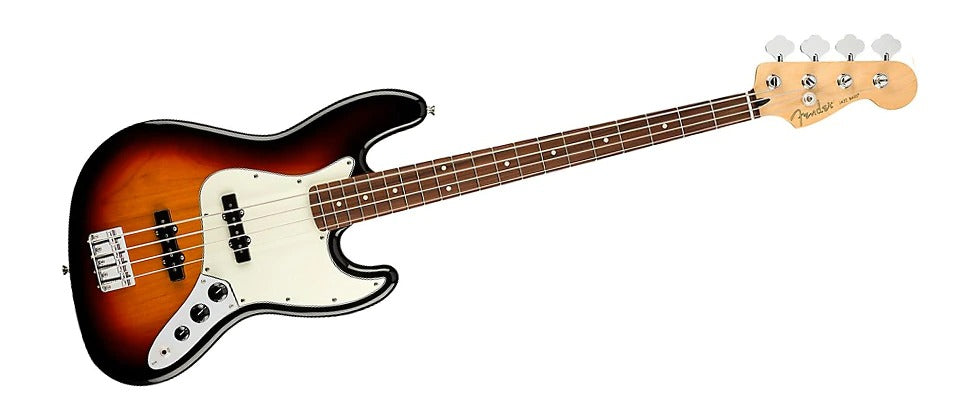
Fender Player Jazz Bass có cấu trúc cần đàn kiểu vít
Một số guitar bass có cần gắn, nghĩa là cần đàn được gắn vào thân đàn bằng khớp mộng hoặc khớp nối chứ không được bắt vít vào thân đàn. Cần đàn cố định tạo ra âm vang và độ ngân tốt hơn, nhưng có thể khó điều chỉnh hơn.
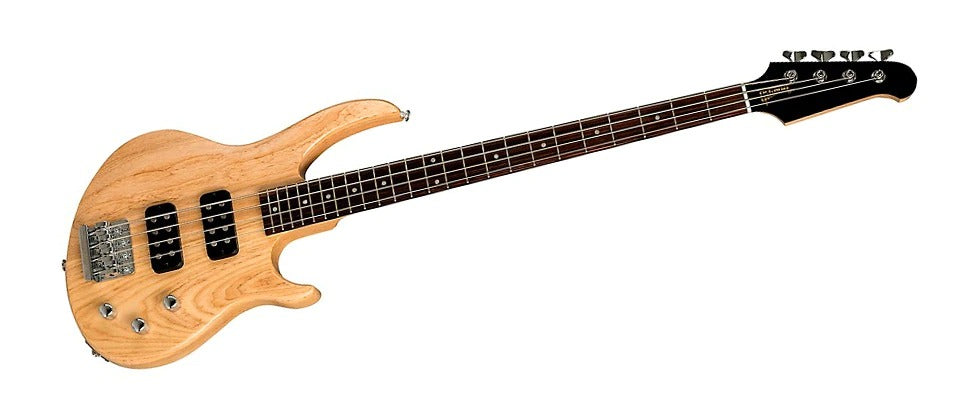
EB-4 Electric Bass có cấu trúc cần gắn truyền thống của Gibson.
Cần đàn xuyên thân được tìm thấy trên những cây đàn guitar bass cao cấp hơn. Loại cần này tiếp tục như một mảnh liên tục xuyên suốt cơ thể. Các cánh được gắn vào mỗi bên của nó để tạo thành phần trên và phần dưới của thân đàn. Với cần xuyên thân, không có khớp nào giữa cần và thân có thể ức chế rung động, dẫn đến phản ứng và độ bền tốt hơn.
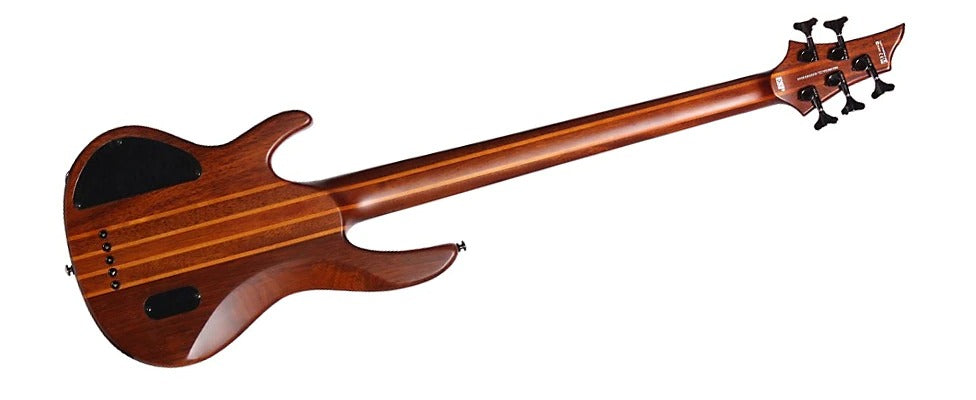
Bass 5 dây ESP LTD-5 có cần đàn xuyên thân
Độ dài thang âm guitar bass:
Thang âm là chiều dài giữa đai ốc (phần có khía giữa cần đàn và đầu đàn) và ngựa đàn nơi các dây được neo. Chiều dài tỷ lệ phổ biến nhất là 34" (86cm)
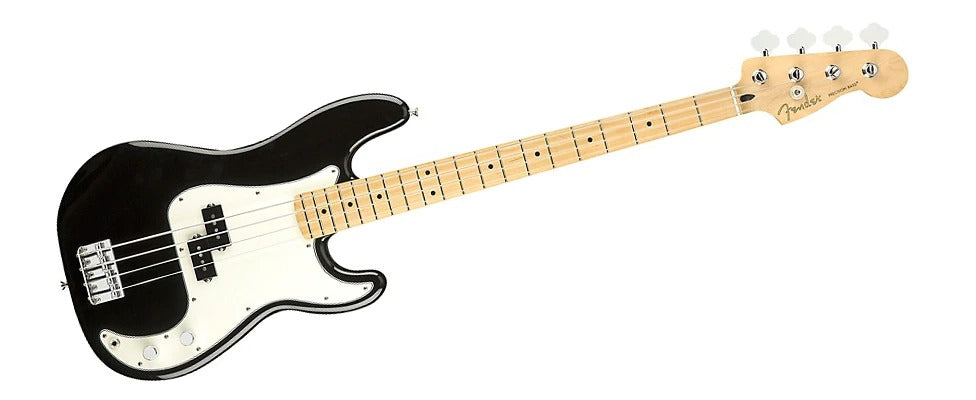
Với thang âm 34”, Fender Player Precision Bass là điển hình của hầu hết các bass điện kích thước tiêu chuẩn khác, có cùng chiều dài thang âm.
Có một vài loại bass quy mô ngắn, chẳng hạn như Fender Mustang, nhiều mẫu Hofner Violin Bass khác nhau hoặc Gibson EBO, khoảng 30" (76cm). Đây là một lựa chọn tốt cho những người chơi có bàn tay nhỏ và có thể gặp khó khăn khi chơi kích thước tiêu chuẩn.
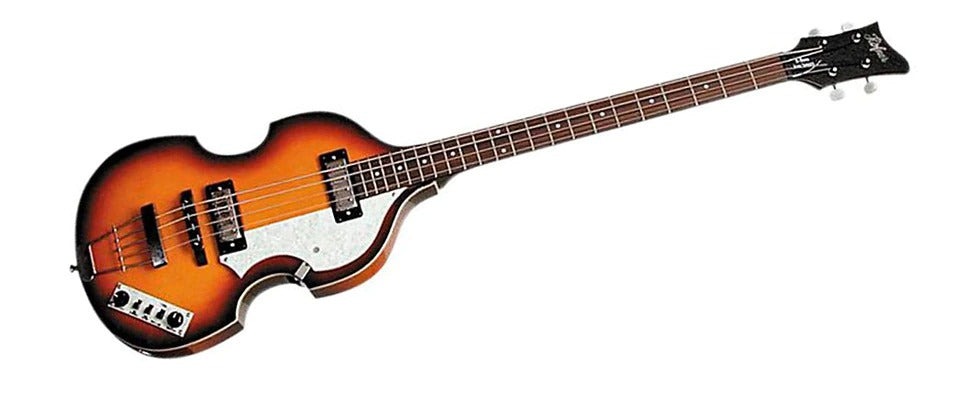
Hofner Ignition Series Violin Bass có thang âm 30” ngắn hơn và dựa trên mẫu nổi tiếng của Paul McCartney.
Cần đàn có thang âm dài là 35" (89cm). Thang âm dài hơn này cung cấp cho bạn thêm một số phím đàn và thường được sử dụng nhất cho guitar bass năm và sáu dây vì nó cải thiện độ căng của dây và giảm thiểu độ mềm ở dây thấp.
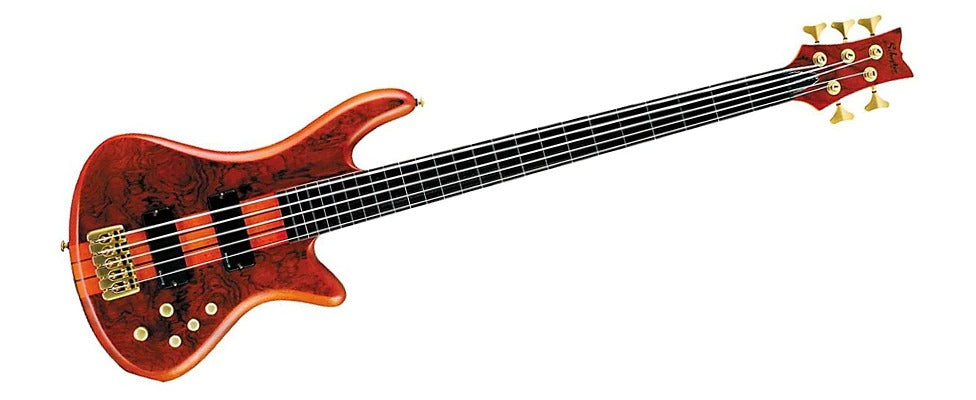
Schecter Stiletto Studio-5 5-String Bass có thang âm dài hơn mức trung bình 35”.
Các Loại Thân Guitar Bass Điện:
Guitar Bass thân đặc là loại phổ biến nhất. Ở những cây đàn tốt hơn, những thân đàn này thường được làm bằng một miếng gỗ đặc—alder, maple, ash, mahogany hoặc một số loại gỗ khác truyền rung động tốt. Ở những loại bass giá rẻ hơn, thân đàn có thể được làm bằng cách sử dụng các lớp gỗ ép. Thậm chí có những chiếc bass có thân bằng nhựa.
Guitar Bass thân rỗng, như bạn có thể đoán, có thân rỗng giống như guitar acoustic nhưng sử dụng bộ thu từ tương tự như bass thân rắn. Chúng được sử dụng chủ yếu bởi những người chơi nhạc jazz và dân gian, cũng như cho âm nhạc nhẹ nhàng hơn và yêu cầu âm sắc giống acoustic hơn. Một cây đàn thân rỗng nổi tiếng, bass "Beatle" của Hofner, là một ví dụ về thân rỗng được sử dụng cho nhạc rock. Guitar bass thân rỗng có ưu điểm là nhẹ hơn, nhưng chúng thường bị hạn chế hơn về âm lượng mà chúng có thể tạo ra vì chúng phản hồi dễ dàng hơn so với guitar bass thân rắn ở âm lượng lớn. Ngoài ra còn có một số bass bán rỗng có khối trung tâm đặc và nửa bên ngoài rỗng của cơ thể. Chúng ít bị phản hồi hơn.
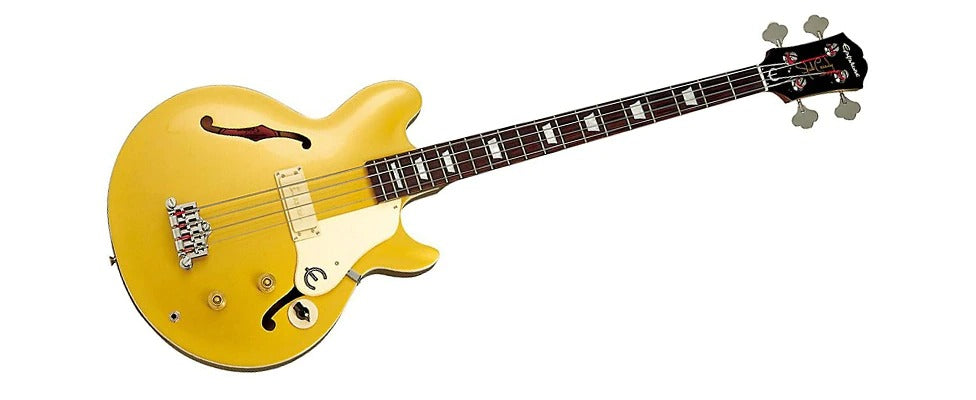
Epiphone Jack Casady Signature Bass có thiết kế bán rỗng giúp tạo ra âm thanh giống như guitar bass acoustic đồng thời chống lại phản hồi.
Một loại guitar bass thân rỗng khác là acoustic gắn EQ. Đây là cây đàn guitar acoustic và thường được trang bị một bộ pickup cho phép nó được khuếch đại. Thông thường, pickup piezo được đặt dưới ngựa, trong khi bộ tiền khuếch đại tích hợp cho phép điều chỉnh âm sắc khi guitar bass được khuếch đại.
Ngựa Guitar Bass
Các dây của guitar bass kết thúc ở ngựa đàn, nơi các rung động của chúng được truyền đến thân đàn tạo ra âm vang và giai điệu mà các bộ phận thu nhận và khuếch đại. Các dây đi qua các rãnh, được gọi là ngựa đàn, có thể di chuyển lên và xuống để điều chỉnh action hoặc tiến và lùi để điều chỉnh ngữ điệu. Những cây ngựa tốt hơn được làm bằng đồng thau và thường được mạ bằng bạc crôm hoặc niken. Một cây ngựa có khối lượng và trọng lượng lớn hơn thường sẽ cố định dây tốt hơn và truyền nhiều rung động hơn từ dây đến thân đàn.
Pickup: Single-Coil hoặc Humbucker
Pickup là thiết bị điện từ thu âm thanh được tạo ra bởi các dây rung và thân của guitar bass, chuyển đổi âm thanh đó thành tín hiệu điện tử. Hầu hết các guitar bass đều có hai bộ pickup để cung cấp dải âm lớn hơn. Pickup gần phím đàn có âm thanh trầm, mượt mà, trong khi pickup gần ngựa đàn hơn có âm sắc nét, trung bình đến cao cấp.
Các loại pickup phổ biến nhất là single-coil và humbucker, và hầu hết các loại khác chỉ đơn giản là các biến thể của một trong hai loại này.
Cuộn dây đơn (pickup đơn) là loại pickup đầu tiên và đơn giản nhất. Mỗi chiếc pickup chỉ có một cuộn dây và một nam châm, giúp tạo ra âm thanh sáng và tập trung. Tuy nhiên, pickup một cuộn dây có thể ồn ào, đó là lý do tại sao pickup humbucking được phát triển.
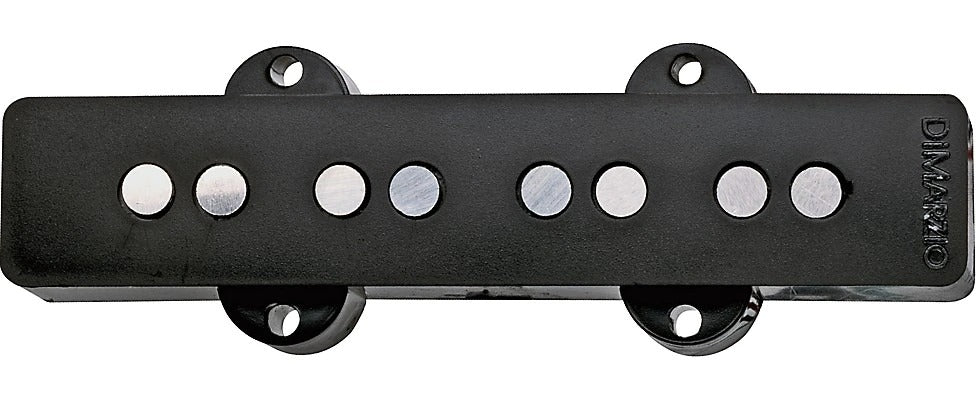
DiMarzio DP148 Ultra Jazz Bass Bridge Pickup là một thiết kế cuộn dây đơn hiện đại giúp loại bỏ tiếng ồn trong khi mở rộng âm thanh truyền thống của Fender Jazz Bass.
Pickup humbucking được tạo ra với nỗ lực loại bỏ tiếng vo ve hoặc tiếng ồn của cuộn dây đơn, nhưng chúng cũng có âm thanh trầm, không có tiếng ồn hơn. Tuy nhiên, âm thanh humbucker có thể trở nên lầy lội ở âm lượng cao hơn.
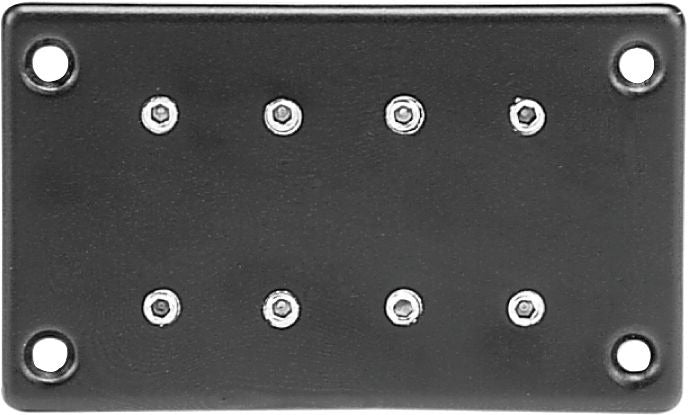
DiMarzio DP1 DP120 Model One Bass Humbucker có nhiều ứng dụng và có thể được sử dụng trong các thiết lập loa trầm/loa tweeter để kiểm soát dải tần cực cao.
Một biến thể phổ biến là cuộn dây phân chia (split-coil) (thiết kế được tìm thấy trên Fender Precision Bass). Nó là một cuộn dây đơn có chức năng giống như một chiếc humbucker. Hai nửa của bộ thu được tách ra và một bên được đảo cực sang bên kia. Do đó, bạn sẽ có được âm thanh gần giống với âm thanh một cuộn dây hơn, nhưng không bị tiếng ồn.
Pickup: Thụ động so với Chủ động (Passive và Active)
Các thuật ngữ chủ động và thụ động đề cập đến mạch tiền khuếch đại của guitar bass. Phần mở đầu tăng cường đầu ra của pickup và cung cấp các điều khiển định hình giai điệu.
Hệ thống tiền khuếch đại thụ động hoạt động mà không cần bất kỳ nguồn điện nào và có ít nút điều khiển hơn, thường là nút âm lượng, nút chỉnh âm sắc và nút điều khiển hòa trộn nếu có hai bộ pickup. Một lợi thế của guitar bass thụ động là nó không phụ thuộc vào pin có thể hết giữa buổi biểu diễn. Một điểm cộng nữa là sự đơn giản. Thiết bị điện tử thụ động có âm thanh low-fi truyền thống hơn trong khi một số người chơi thích âm thanh hi-fi của thiết bị điện tử chủ động.
Guitar bass hoạt động cần nguồn điện, thường được cung cấp bởi pin tích hợp. Ưu điểm của hệ thống tiền khuếch đại chủ động là đầu ra mạnh hơn và kiểm soát nhiều hơn đối với việc định hình giai điệu. Guitar bass Active thường có các điều khiển EQ riêng biệt được chia thành các dải tần số, chẳng hạn như điều khiển tăng/giảm tần số thấp, trung bình và cao. Chúng cũng có thể có các công tắc giúp định hình lại cấu hình EQ ngay lập tức. Một số có bộ điều khiển cho phép bạn thay đổi hệ thống dây điện của pickup một cách nhanh chóng từ nối tiếp sang song song để có những thay đổi âm sắc ấn tượng. Một công tắc nhấn cuộn dây được tìm thấy trên một số guitar bass có thiết bị điện tử Active sẽ tắt một bộ cuộn dây trong bộ pickup humbucking để làm cho âm thanh giống như một cuộn dây đơn.
Nên bắt đầu với guitar bass bao nhiêu dây?
Guitar Bass bốn dây
Hầu hết guitar bass đều có bốn dây và những người mới chơi có lẽ nên bắt đầu với guitar bass bốn dây . Những guitar bass này hoàn toàn phù hợp với hầu hết các phong cách âm nhạc và cần đàn nhỏ hơn so với những guitar bass năm và sáu dây, giúp chúng dễ xử lý và học tập hơn.
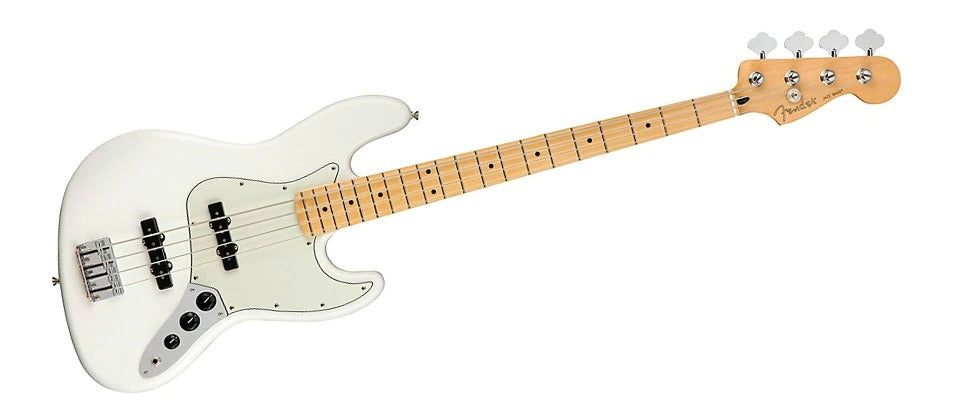
Fender Player Jazz Bass 4 dây là một trong những cây bass điện mang tính biểu tượng nhất từ trước đến nay; bản gốc đã được phát triển vào năm 1960 bởi Leo Fender.
Guitar Bass 5 và 6 dây
Guitar bass năm dây thêm một dây B thấp hơn, giúp cây đàn có âm vực sâu hơn. Cần đàn của bass 5 dây nhất thiết phải rộng hơn 4 dây nên khó chơi hơn một chút. Bass năm dây phổ biến với một số nghệ sĩ bass hard rock, metal, fusion và jazz.
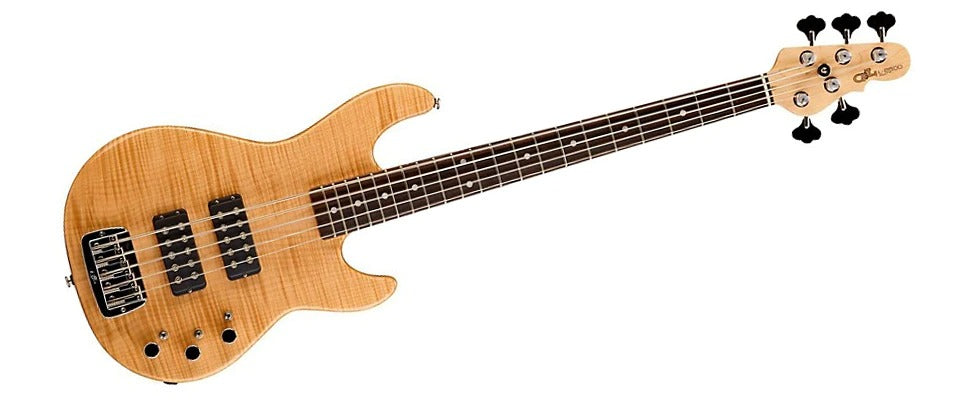
Với dây B thấp bổ sung, G&L L-2500 Bass 5 dây cung cấp phạm vi mở rộng.
Bass sáu dây thậm chí còn có phạm vi mở rộng hơn do có dây B thấp và dây C cao. Sáu dây yêu cầu cần đàn rộng hơn, điều này có thể gây khó khăn cho nhiều người chơi. Mặc dù đầy thách thức, nhưng chúng rất lý tưởng cho những người chơi bass chơi solo vì chúng mở rộng phạm vi và tạo điều kiện cho sự sáng tạo lớn hơn.
Bass không phím
Những cây guitar bass tiêu chuẩn có cần có phím đàn, với các phím đàn bằng kim loại chia phím đàn thành từng quãng nửa cung. Những phím đàn này giúp bạn dễ dàng nhìn thấy từng nốt được chơi trên cần đàn.
Tuy nhiên, guitar bass không phím đàn có phần cần mượt mà, tương tự như một guitar bass upright hoặc vĩ cầm. Đánh đúng nốt với đúng ngữ điệu là một thử thách và không dành cho người mới bắt đầu. Những người chơi bass không phím luôn luôn dựa vào trí nhớ và một đôi tai được đào tạo tốt. Họ chọn guitar bass không phím vì âm thanh mượt mà, ấm áp hơn và khả năng cung cấp các hiệu ứng glissando giống như guitar bass acoustic độc lập.
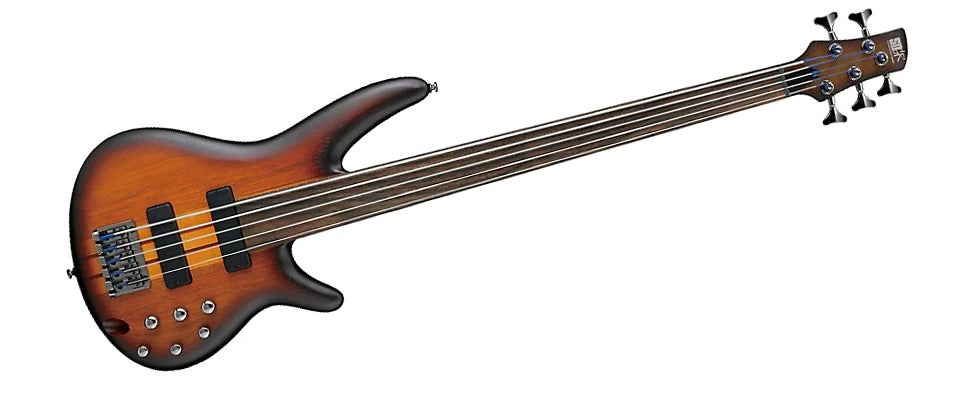
Ibanez SRF705 Portamento 5-String Electric Bass không phím mang đến âm thanh mạnh mẽ nhưng khó chơi hơn so với bass có phím đàn.
Các loại gỗ làm đàn guitar bass:
Loại gỗ được sử dụng làm thân đàn guitar bass sẽ ảnh hưởng đến âm sắc và độ cộng hưởng của nó. Người mới chơi không cần quá quan tâm đến loại gỗ làm thân đàn guitar bass của mình. Nhưng nếu bạn đang tìm kiếm một âm thanh cụ thể từ guitar bass, thì gỗ thân đàn có thể là một yếu tố quan trọng.
Gỗ Alder
Alder thường được sử dụng cho thân đàn guitar bass. Nó tạo ra một giai điệu rất cân bằng, với độ rõ nét tuyệt vời và âm thanh rất đầy đủ.
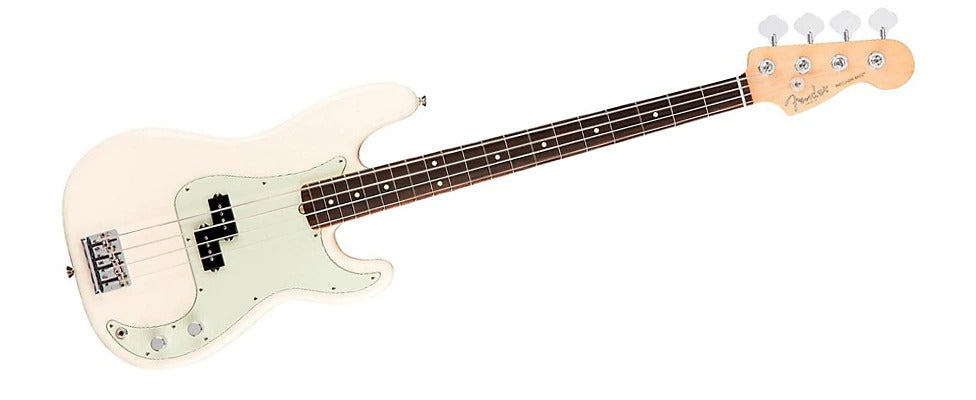
Thân đàn của Fender American Professional Precision Bass tạo ra độ rõ nét và độ bền tuyệt vời.
Agathis
Agathis là một loại thân gỗ phổ biến vì nó tương đối rẻ. Nó cung cấp một giai điệu khá cân bằng với một chút nhấn mạnh vào các âm trung bình thấp mang lại âm thanh phong phú.
Ash
Có một số loại Ash được sử dụng trên thân đàn guitar bass, với những khác biệt nhỏ, nhưng nhìn chung loại gỗ này tạo ra âm thanh sáng và đầy đủ, tương tự như gỗ alder. Swamp ash đặc biệt được ưa chuộng do vân đẹp của nó.
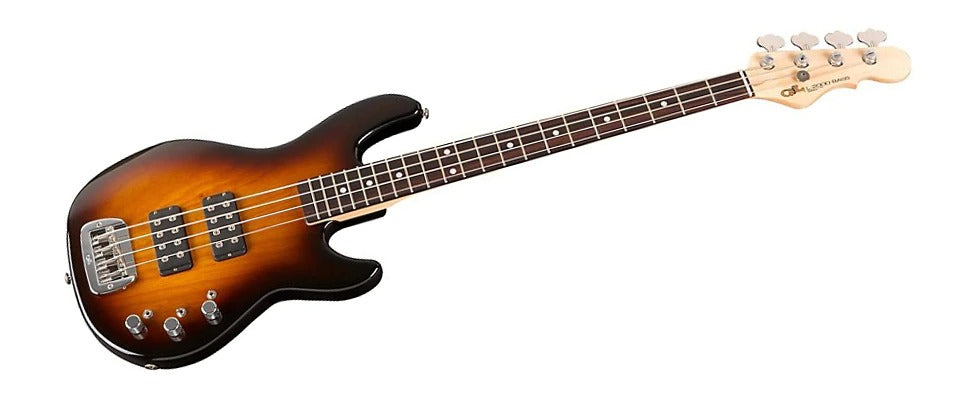
Lớp hoàn thiện được áp dụng cho thân gỗ tần bì của G&L L-2000 Bass làm tăng thêm vẻ đẹp cho hình dáng và âm hưởng tự nhiên của gỗ.
Basswood
Thường được sử dụng trên các cây đàn rẻ tiền hơn, nó là một loại gỗ mềm hơn, không gây được tiếng vang nhiều như các loại gỗ khác. Một số người chơi bass cho rằng điều này tạo ra âm thanh phẳng, trong khi những người khác cảm thấy guitar bass ngắn là lý tưởng cho các kỹ thuật chơi nhanh và phức tạp.
Mahogany
Gỗ mahogany là một loại gỗ có tông phổ biến cho guitar bass vì nó tạo ra âm sắc mềm mại, ấm áp, làm nổi bật các âm trung và trầm, đồng thời tạo ra độ ngân lâu hơn. Tuy nhiên, nó là một loại gỗ dày đặc và bạn sẽ cảm thấy nặng hơn trên vai so với tần bì hoặc agathis.
Maple
Maple cũng là một loại gỗ dày đặc, vì vậy nó tạo ra âm thanh được duy trì tốt như gỗ mahogany. Tuy nhiên, Maple tạo ra âm sắc tươi sáng, rõ ràng mà nhiều nhạc sĩ thấy có giá trị trong bối cảnh phòng thu.
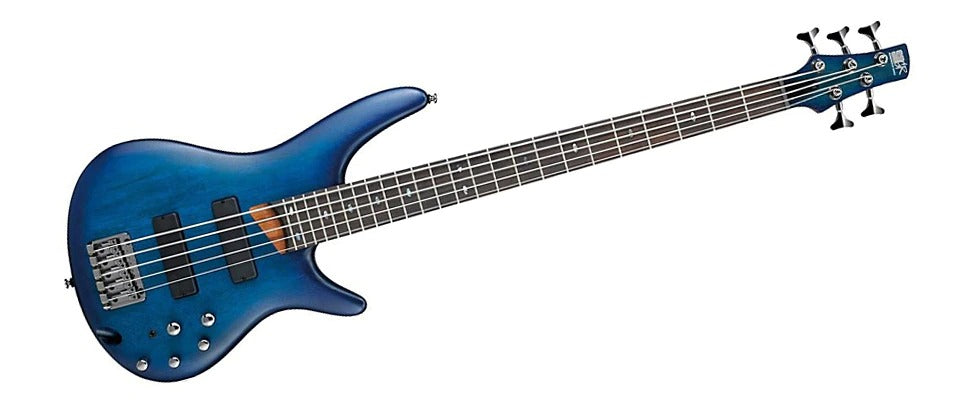
NS Design CR5 Radius Fretless Bass có thân đàn bằng gỗ maple với mặt trên lộng lẫy kết hợp với thiết kế cần đàn sáng tạo và hệ thống pickup cho âm thanh, khả năng chơi và hình ảnh tuyệt đẹp.
Nhiều loại gỗ khác được sử dụng cho guitar bass. Các cây đàn cao cấp có thể được làm bằng các loài quý hiếm như bubinga, wenge, koa hoặc cocobolo.
Vậy guitar Bass nào phù hợp với tôi?
Dưới đây là một số nguyên tắc (không phải quy tắc) dành cho người mua guitar bass lần đầu:
• Mua bass tốt nhất bạn có thể mua được. Một guitar bass tốt sẽ giúp việc học trở nên dễ dàng hơn và bạn sẽ không phải đổi đàn sau này quá nhanh.
• Chọn cây đàn có phím đàn, trừ khi bạn đã sẵn sàng cho thử thách với cây đàn không phím.
• Chọn bass thang âm ngắn nếu bạn có vóc dáng nhỏ hoặc có bàn tay nhỏ.
• Để đơn giản, hãy chọn một cây đàn 4 dây.
• Chọn guitar bass với các nút điều khiển đơn giản để bạn có thể tập trung luyện tập và không bị phân tâm bởi các tùy chọn điều khiển.
• Chọn một cây bass có màu sắc và hình dạng hấp dẫn bạn. Vẻ ngoài của nó sẽ không làm cho âm thanh hay hơn, nhưng guitar bass trông bắt mắt có thể thúc đẩy bạn chơi nhiều hơn.
Xem thêm:

